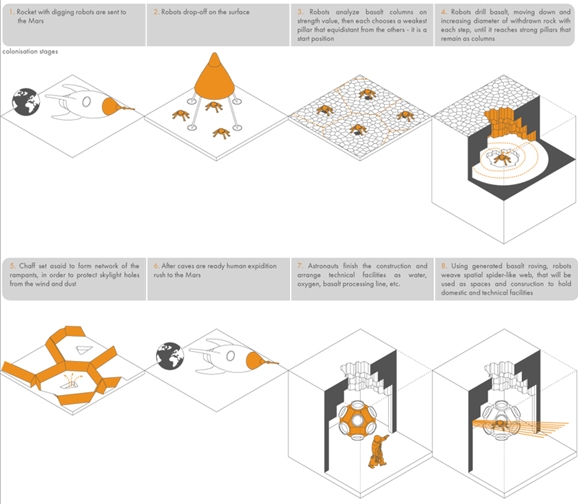Mars Colony Proposal Would Send Robots Ahead To Carve Out Underground Facilities
This article is more than 2 years old
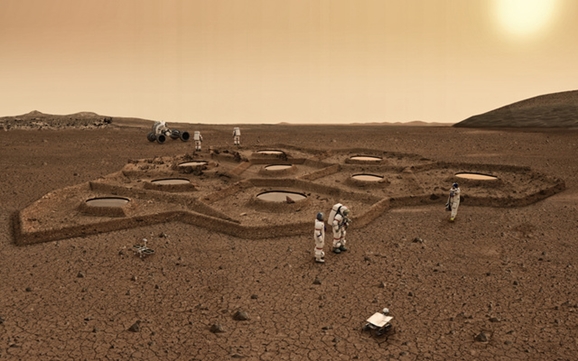 We’ve heard a lot about Mars, and the dream of sending humans there, in recent years. The landing of the Curiosity rover put both the red planet, and space exploration in general, back in the headlines in a way it hadn’t been in a while. Hell, there’s even a reality show offering to make a select few volunteers the very first Mars colonists (although it’s a one-way trip). But while mankind has been dreaming of leaving human bootprints in Mars’ red soil for decades, figuring out the logistics of how to make it happen are challenging to say the least. Not only do you have to get people there safely, you have to ensure their survival once they get there. Now a group of German architects is proposing a clever way to create permanent buildings on Mars before any humans arrive. They’re heading underground.
We’ve heard a lot about Mars, and the dream of sending humans there, in recent years. The landing of the Curiosity rover put both the red planet, and space exploration in general, back in the headlines in a way it hadn’t been in a while. Hell, there’s even a reality show offering to make a select few volunteers the very first Mars colonists (although it’s a one-way trip). But while mankind has been dreaming of leaving human bootprints in Mars’ red soil for decades, figuring out the logistics of how to make it happen are challenging to say the least. Not only do you have to get people there safely, you have to ensure their survival once they get there. Now a group of German architects is proposing a clever way to create permanent buildings on Mars before any humans arrive. They’re heading underground.
ZA Architects’ vision of Mars settlement involves sending specialized robots ahead of any human missions. Once on Mars, the ‘bots would begin digging into Mars’ surface to create underground facilities, which would then be ready and waiting for astronauts/colonists to inhabit and finish out. The plan would take advantage of Mars’ soil, which is rich in basalt. As the architects’ website explains, “Basalt is good material to make a protectional cave on, to produce insulation, and basalt roving, which is stronger than steel.”
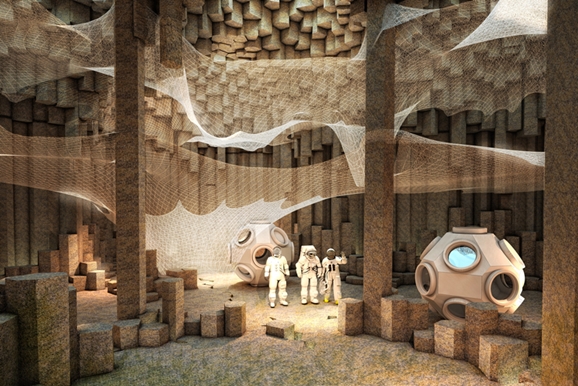
If you’re reaching for Google to look up “basalt roving,” don’t worry, you’re not alone. Via Technoblast, basalt roving is described as:
[a] bundle of continuous monodirectional complex basalt fibers. Roving possesses high natural strength, resistance to aggressive environments, long service life and excellent electric insulating properties. By its technical characteristics, Basalt roving surpasses S-glass and E-glass by many parameters, and is almost as good as carbon. Basalt roving is extremely heat resistant: long-use temperature range is -200 +6800С. Temporarily it can work in up to 900 0С. Roving is extremely hard: 8-9 on the Moh scale (for comparison diamond=10). Its specific strength is 2,5 times higher than alloy steel’s and 1,3 times higher than E-glass.
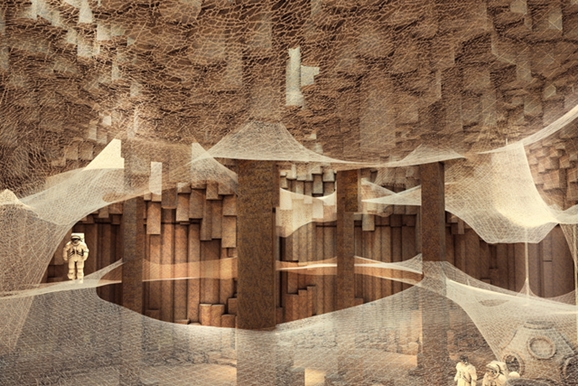
So yeah: a sturdy material, to be sure. In the picture above, the weblike material strung throughout the room is meant to be made of basalt roving. The roving would be used as flooring to provide the underground facilities with different “levels.” You wouldn’t think walking on that fragile-looking material would be wise, but again: stronger than steel. Architect Arina Ageeva says, “This material is already in use in the aerospace and automotive industries. It is stronger and lighter than steel, easier to operate, fireproof and it does not corrode.”
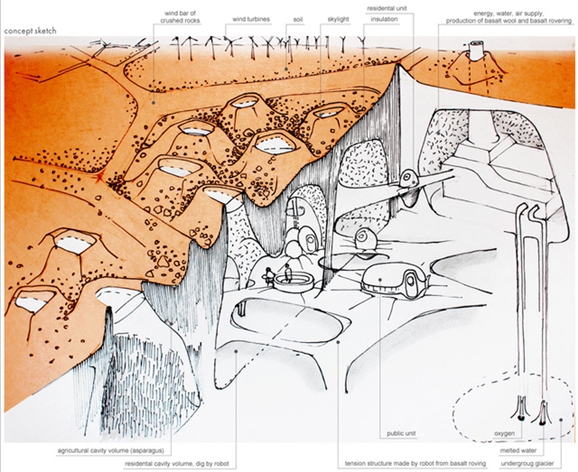
The underground facilities would have skylights in the ceilings to allow natural light to reach into the caverns, which could also be useful for purposes of agriculture. (In case everybody gets sick of spinach). Here’s a handy infographic breaking down the process, which you can click for a larger, easier-to-read version.
The only problem, which the group freely acknowledges, is that we don’t currently have robots who could manage a project this large and complex. However, given the rate this sort of technology seems to be advancing these days, it seems likely that the capability to pull this off isn’t too far off in the future. 3D printing technology is accomplishing similar tasks with remarkable results across multiple fields. Indeed, 3D printing has already been suggested as a way to construct similar housing on the Moon, whenever mankind decides to return. The idea of sending automated devices ahead to construct housing using materials available on site is brilliant, and would help limit how much stuff we have to haul from here to there before we can get started.
